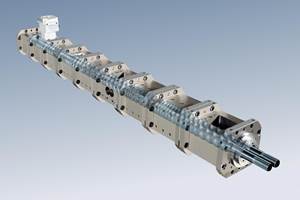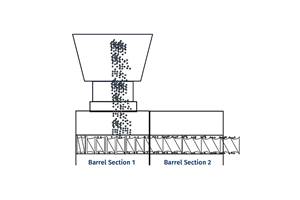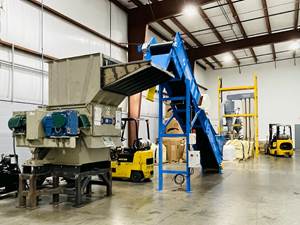Understanding 'Boundary Conditions' in Twin-Screw Compounding
In twin-screw compounding, the objective is generally to produce the highest quality product at the maximum strand. But sometimes there are operating parameters that prevent this objective from being realized.
Co-rotating, intermeshing twin screw extruders (TSE) mix plastics with additives and fillers to impart desired properties into the final product. Dispersive/distributive mixing and venting are strategically performed in the TSE process section. As with most manufacturing operations, in the twin screw system it is often the goal to operate at the maximum attainable rate while making a quality product.
A “boundary condition” is the operating parameter that prevents higher throughput rates from being produced. A simple example is screw speed/rpm, so if screw rpm are increased from 400 to 800, output might also be doubled, as long as another boundary condition was not encountered.
Examples of typical boundary conditions are as follows:
- Torque: A torque-limited process occurs when there’s not enough power (kW or hp) from the motor to turn the screws and pump the materials through the TSE process section and front end/die system. The screw shaft is what limits torque transmission in a TSE. The screw shaft rating is denoted in Newton-Meters (Nm) or equivalent (both shafts) and design factors include: cross-section shaft dimension, shaft metallurgy, spline geometry and shaft hardening process. State-of-the art asymmetrical splined shafts transmit power from the motor isolating a tangential force vector into the screws.

TSE element of an asymmetrical splined shaft.
Source (all images): Leistritz Extrusion USA
Processing of a fractional melt HDPE or PP formulation might be torque limited, so a TSE with a higher Nm torque rating (all else being equal) run at a higher rate than TSE with a lower torque rating. TSE factors to increase the rate for a torque-limited process might involve removing kneading elements and increasing the zone temperature set points in the melting zone.
- Volume: A process is a volume-limited process when the free volume in the TSE keeps more material from being metered into the process section. The outside screw diameter divided by the inside screw diameter, referred to as the OD/ID ratio, is an indicator of the available free volume in a TSE at a given screw diameter.
Increasing the screws’ rpm and/or decreasing the rate generally improves devolatilization efficiencies.
Because twin-screw manufactures do not have standardized screw sizes, the cc’s/diameter is the best indicator. As an example, when comparing a 70-mm TSE with 1.55 OD/ID ratio with 240 cc/diameter to a ZSE-75 MAXX with 1.66 OD/ID ratio with 300 cc/diameter, you can expect a 30% throughput rate increase, all else being equal.

Free volume (in orange) of a Leistritz ZSE-MAXX process section.
Other factors that can increase the attainable rate of a volume-limited process are targeted at maintaining feed densities and can include: material handling equipment; minimizing the drop distance of the loss-in-weight feeder to the TSE (or side stuffer); oversizing side stuffer screws with baffled drop chute; utilizing vacuum assist processing; adjusting barrel temperature profiles; and manipulating screw and vent design in the TSE process section.
- Mass Transfer-Dispersive Mixing: Dispersive mixing requirements for color masterbatch for thin film or fiber processes may set the boundary condition and be the limiting factor to achieve higher rates. Dispersive mixing relies on the strong forces being applied by rotating screws to the polymer matrix. Wider kneading elements accentuate extensional mixing and planar shear effects that result in dispersive mixing. Narrow kneading elements, by comparison, facilitate high division rate mixing with minimal extensional effects, causing a distributive mixing effect. Kneading elements can be arranged with a forward pitch (less aggressive), neutral or reverse pitch.

Mixing mechanism in wide mixing/kneading elements for dispersive mixing.
The mixing effects inherent with any TSE are influenced by:
- Channel region: The mixing rate in the TSE channel is similar to a single screw extruder (and much lower compared to the other TSE regions).
- Overflight gap: Between the screw tip and the barrel wall is where the material undergoes significant planar shear effects.
- Extensional mixing: Extensional mixing occurs as the material “accelerates, stretches and breaks” in the transition from the channel to the overflight gap.
- Apex (upper/lower) region: Upper and lower apex regions are where the material “feels” the second screw which results in directional flow changes, compression/expansion and axial mixing effects.
- Intermesh: A small, finite amount of material passes between the screws and experiences intensive shear forces (and maybe degradation).
Feed rate versus screw rpm determines the residence time distribution and, with the screw design and temperature profile, regulates the mass transfer/mixing properties of the process.

Examples of kneading blocks. Narrow disks promote distributive mixing; wide disks promote dispersive mixing.
Dispersive mixing applications run at comparatively lower throughput rates. As the rates are decreased or increased (at a constant screw rpm) the materials spend more or less time in mixing zones where shear effects and extension flow fields are dominant, and thus the “mixing experience” is impacted.
- Mass Transfer-Devolatilization/Removal of Gases: TSEs are well suited for devolatilization as the pressure gradient in the TSE process section is easily designed to accommodate zero pressures under the vents to prevent vent flooding. Devolatilization is a mass transfer limited process where unreacted monomer, solvent, water or other undesirable volatile contaminants are removed from a polymer melt during the TSE process (up to 25% is viable).
Extended residence times at elevated temperatures may be the primary cause of degradation
Increasing the screws’ rpm and/or decreasing the rate generally improves devolatilization efficiencies. Vents can be sequenced and atmospheric, or vacuum can be applied to further enhance devolatilization effects. At high screw rpm, degradation of the formulation may occur.

Heated vent stacks equipped for vacuum hookup on ZSE-MAXX process section.
Factors that affect devolatilization efficiencies include:
1. Residence time under the vent or vents. Longer is better but ...
- Oxygen, shear, time and temperature may contribute to degradation and side reactions
- Understand the kinetics of degradation
2. Surface area of the melt. Higher is better
- Smaller melt pools
- Increase screw rpm
- Decrease rate
- Surface renewal. Higher is better:
- Renewed surfaces come from rolling pools and partially filled screw channels
- Increase screw rpm
The residence time in a twin screw process section is typically in the 15 seconds to 1+ minute range. Extended residence times at elevated temperatures may be the primary cause of degradation compared to the TSE discharge Tm. Front-end systems that include screen changers, gear pumps and dies will dictate a lower Tm input requirement from the TSE.
- Scarcity/Cost of Raw Materials During the R&D Phase: In early-stage development, there is often limited amounts of expensive materials available. So the challenge is to extrude a usable sample that can be scaled up. To accommodate limited batch processing, twin screw extruders are specified with low volume screws (1.2/1 OD/ID ratio with 1 cc diameter. Free volume) and specialty feed mechanisms for microbatch sampling. (for example, 50 gms total) to enable sampling for scale-up purposes.

Patented micro-plunger feeder for small-batch processing on a TSE.
- Upstream and/or Downstream Limitations: A TSE system is just like a chain, it’s only as strong as the weakest link. There are typically multiple feed streams to the twin screw extruder and a variety of auxiliary equipment. A die and downstream system are then attached to the TSE front end. If any component in the manufacturing “train” does not do the job, the overall kgs/hr of the system will be limited by that piece of equipment.
About the Author: Charlie Martin is president of Leistritz Extrusion USA, a company that provides compounding equipment and engineering services to the plastics, medical and pharmaceutical markets. Martin has delivered technical presentations at wide-ranging events around the world and is the co-editor of the textbook Pharmaceutical Extrusion Technology. He serves on the board of directors for the Society of Plastics Engineers Extrusion Division, and the Polymer Processing Institute. He also serves on the Bioplastics Division Committee for the Plastics Industry Association. Contact: 908-685-2333; cmartin@leistritz-extrusion.com; extruders.leistritz.com
Related Content
How to Configure Your Twin-Screw Barrel Layout
In twin-screw compounding, most engineers recognize the benefits of being able to configure screw elements. Here’s what you need to know about sequencing barrel sections.
Read MoreImproving Twin-Screw Compounding of Reinforced Polyolefins
Compounders face a number of processing challenges when incorporating a high loading of low-bulk-density mineral filler into polyolefins. Here are some possible solutions.
Read MoreHow to Configure Your Twin-Screw Extruder -- Part 2
Follow these tips to configure your twin-screw elements to promote feeding and solids conveying.
Read MoreEngineering Resins Compounder Expands to Take on More Scrap
Polymer Resources responds to sustainability push by upgrading plant with grinding and shredding equipment to take on both postindustrial and postconsumer reclaim.
Read MoreRead Next
Lead the Conversation, Change the Conversation
Coverage of single-use plastics can be both misleading and demoralizing. Here are 10 tips for changing the perception of the plastics industry at your company and in your community.
Read MorePeople 4.0 – How to Get Buy-In from Your Staff for Industry 4.0 Systems
Implementing a production monitoring system as the foundation of a ‘smart factory’ is about integrating people with new technology as much as it is about integrating machines and computers. Here are tips from a company that has gone through the process.
Read MoreSee Recyclers Close the Loop on Trade Show Production Scrap at NPE2024
A collaboration between show organizer PLASTICS, recycler CPR and size reduction experts WEIMA and Conair recovered and recycled all production scrap at NPE2024.
Read More





















